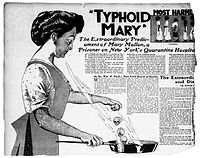
Photo from wikipedia
Introduction: Previous studies report high rates of postoperative morbidity and mortality among COVID-19 patients. With routine preoperative screening, we are identifying an increasing number of patients with asymptomatic and mild… Click to show full abstract
Introduction: Previous studies report high rates of postoperative morbidity and mortality among COVID-19 patients. With routine preoperative screening, we are identifying an increasing number of patients with asymptomatic and mild COVID-19. Our objective was to determine the risk of perioperative morbidity and mortality among patients with asymptomatic or mild COVID-19. Methods: A multicenter, retrospective study of patients with asymptomatic or mild SARS-CoV-2 infection (severity definitions developed by Chinese CDC), diagnosed within 8 days of surgery from March 2020 to February 2021. Primary outcome was 30-day mortality. Secondary outcomes included pulmonary and thromboembolic complications. Results: Study cohort consisted of 54 patients. Median age was 50y (interquartile range [IQR] 37.5-62.5y), median BMI was 28.8 kg/m2 (IQR 23.5-31.3kg/m2), and 67.3% had no comorbidities. SARS-CoV-2 infection was detected preoperatively in 75%, and 26.7% had lung infiltrates seen on admission imaging. Before admission, 92.3% of patients were asymptomatic, and 7.7% had mild COVID-19 symptoms. Of the procedures, 40.3% were general surgery and 21.2% orthopaedic, the remaining 38.5% were subspecialties. General anesthesia was used in 86.5% of cases and laparoscopy was used in 25%. Overall mortality was 0%. Overall rates of postoperative pulmonary and thromboembolic complications were 9.6% and 1.9%, respectively. New COVID-19 symptoms developed in 19.2% of patients postoperatively. [Formula presented] Conclusion: Postoperative complications and overall mortality appear low in patients with asymptomatic and mild COVID-19 diagnosed in the perioperative period. This suggests surgery can still be considered in these cases when the risks involved with nonoperative management may exceed the risk associated with asymptomatic and mild COVID-19.
Journal Title: Journal of the American College of Surgeons
Year Published: 2021
Link to full text (if available)
Share on Social Media: Sign Up to like & get
recommendations!